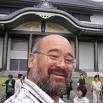|
Introduction and Preface
to the Ongi Kuden: Namu Myoho Renge Kyo [Devotion to the Lotus Sutra] “Namu derives from Sanskrit, and here [in Japan] it is
rendered as kimyo , meaning ‘to devote one’s life.’ This means to devote one’s life to
the Person and the Law. Devotion to the Law means to devote one’s life to the Lotus Sutra. Devotion to the
Person means to devote one’s life to Shakyamuni. Devotion of one’s life means both the physical law of life
and the spiritual law of life. The ultimate principle embodies the oneness of these two. In addition, devotion,
(ki) indicates dedicating our lives to the principle of the eternal and unchanging truth revealed in the theoretical
teachings of the Lotus Sutra. ‘Life’ (myo) means to base ourselves upon wisdom that functions
in accord with changing circumstances as revealed in the essential teaching of the Lotus Sutra. Thus, to ‘devote
one’s own life’ is the very meaning of Nam Myoho Renge Kyo. T'ien-t'ai states ‘The eternal and unchanging
truth and wisdom that functions in accord with changing circumstances are at each moment both contained within life, which
embodies and permeates all phenomena.’”
Additionally, ‘to devote’ expresses
our physical aspect and ‘life’ our spiritual aspect. The supreme principle reveals that the physical and the spiritual
are one and inseparable within the ultimate reality of life. T'ien-t'ai states that because we devote our lives to the
ultimate reality, our devotion is called the Buddha vehicle. Also, while “ of Nam Myoho Renge Kyo derives
from Sanskrit, Myoho Renge Kyo derives from the Chinese language. Therefore Nam Myoho Renge Kyo comprises both Chinese
and Sanskrit. Moreover, in Sanskrit, one says Saddharma pundarika sutram which is rendered as Nam Myoho
Renge Kyo. Sad translates as Myo, dharma as Ho, pundarika as Renge and sutram
to Kyo. These nine characters correspond to the nine honored ones and express the principle that the nine worlds
inherently possess the Buddha nature. Myo represents the nature of enlightenment, while ho, indicates
darkness or delusion. The oneness of delusion and enlightenment is called Myoho, the Mystic Law. Renge
represents the principles of cause and effect, and also indicates the simultaneity of cause and effect. Kyo indicates
the words and speech, sounds and voices of all sentient beings. Chang-an states, ‘The voice does the Buddha’s
work.’, and is therefore called kyo. Kyo also signifies that life spans the three existences of
past, present and future. All things are Myoho, all things are Renge, all things are Kyo.
Renge means the Buddha’s body encompassed by the nine honored ones on the eight petalled lotus. You should
ponder this carefully.” (Gosho Zenshu p.708)
|

